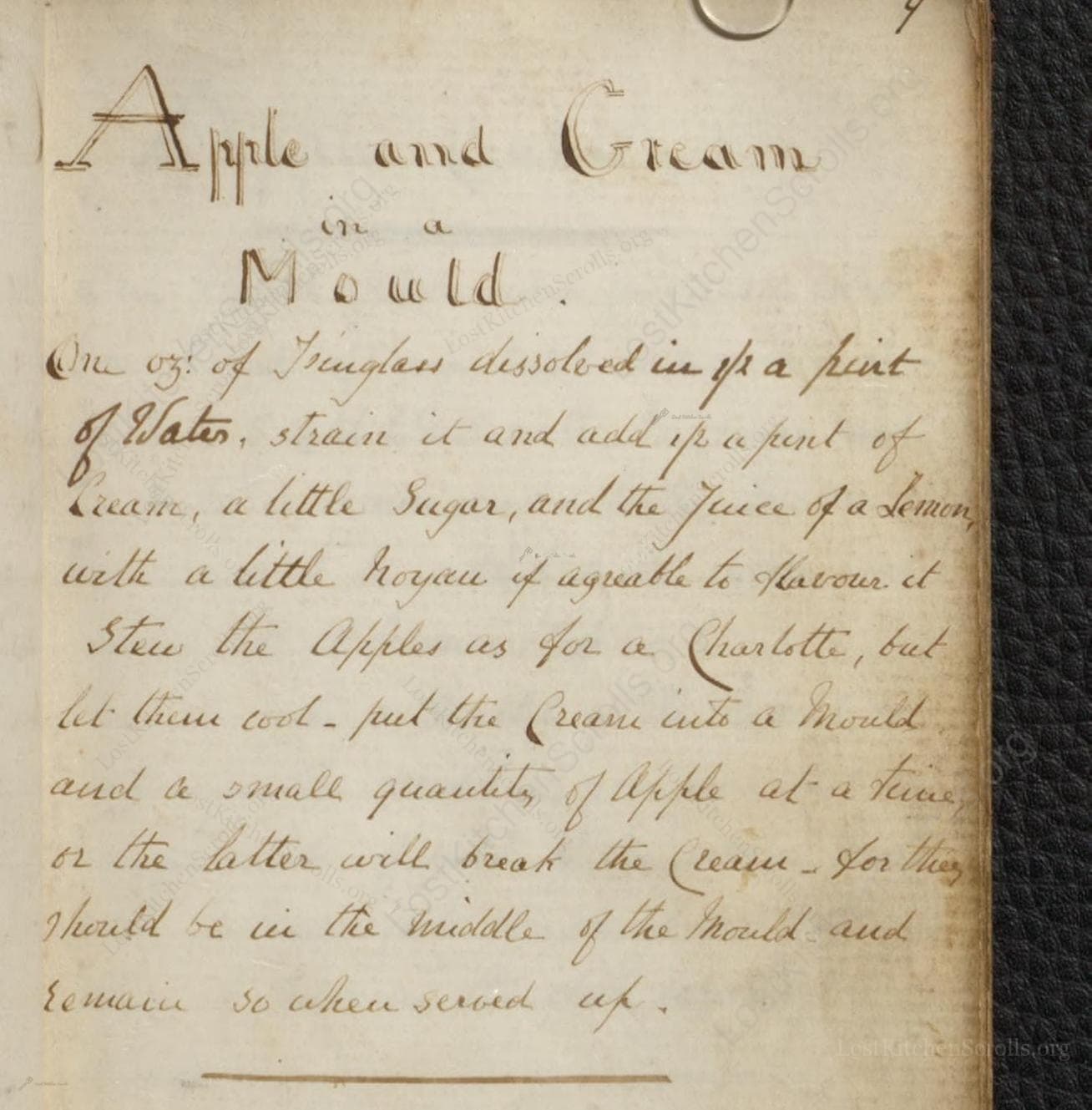Apple And Cream In A Mould
From the treasured pages of Recipe book of Charles Ellice, Colonel, 24th Regiment
Written by Charles Ellice, Colonel

Apple And Cream In A Mould
"One oz: of Isinglass dissolved in 1/2 a pint of Water, strain it and add 1/2 a pint of Cream, a little Sugar, and the Juice of a Lemon, with a little Noyau if agreeable to flavour it. Stew the Apples as for a Charlotte, but let them cool - put the Cream into a Mould and a small quantity of Apple at a time or the latter will break the Cream - For this should be in the middle of the Mould and remain so when served up."
Note on the Original Text
Recipes from this period were often concise, presuming an experienced household cook or steward who intuitively understood methods and quantities. 'Ounces' were a common measure, and terms like 'Noyau' could be used without further explanation, assuming familiarity with fashionable liqueurs. Spellings and terminology, like 'isinglass' for setting, reflect contemporary practices before gelatine became standard. Directions are brief, outlining the sequence of operations without precise temperatures or times, typical of mid-Victorian kitchen writing.

Title
Recipe book of Charles Ellice, Colonel, 24th Regiment (1856)
You can also click the book image above to peruse the original tome
Writer
Charles Ellice, Colonel
Era
1856
Publisher
Colonel Charles Ellice
Background
A charming manuscript cookbook chronicling the culinary escapades of Colonel Charles Ellice during his globe-trotting military career, featuring recipes from Highland butter to yeastless bread, spicy curries, and even a dash of Victorian medicine—all penned alongside evocative ink sketches and a personal index.
Kindly made available by
McGill University
This recipe hails from a mid-to-late nineteenth-century manuscript kept by Colonel Charles Henry Ellice, a career officer in the British Army, much of whose service was spent in colonial India. The handwritten cookbook illustrates the culinary experiences of a high-ranking British officer adapting both home favourites and exotic influences while abroad. With a mixture of elegant British fare and practical techniques for improvised kitchens, this recipe for Apple and Cream in a Mould would have served as a refined yet achievable dessert. It reflects both the Victorian flair for elaborate table presentations and the period's developing use of setting agents like isinglass, preceding widespread gelatine.

To prepare this dish in the 19th century, a cook would have used a sturdy saucepan for dissolving isinglass, a wooden spoon for stirring, and a fine strainer or muslin cloth to strain the solution. Apples would be stewed in an iron or copper pan. A decorative tin or ceramic mould was essential for forming and presenting the set pudding. For cooling and setting, the dish would be left in a cool pantry or ice-box if available. To unmould, the cook might dip the base briefly in warm water to release the set cream.
Prep Time
15 mins
Cook Time
15 mins
Servings
6
We've done our best to adapt this historical recipe for modern kitchens, but some details may still need refinement. We warmly welcome feedback from fellow cooks and culinary historians — your insights support the entire community!
Ingredients
- 1 oz isinglass (or 2 tsp powdered gelatin as substitute)
- 8 fl oz water
- 8 fl oz double cream
- 1–2 tbsp caster sugar (adjust to taste)
- Juice of 1 lemon
- 10–12 oz apples (dessert apples, peeled, cored, sliced)
- Optional: 1–2 tsp Noyau liqueur (or almond extract as substitute)
Instructions
- Begin by dissolving 1 ounce of isinglass or 2 teaspoons powdered gelatin in 8 fl oz of water.
- Strain, then stir in 8 fl oz double cream, 1–2 tablespoons caster sugar (to taste), and the juice of one lemon.
- Optionally, add 1–2 teaspoons of Noyau (an almond-flavoured liqueur) to flavour.
- Stew peeled and sliced apples with a little sugar until tender (much like for a Charlotte), then let them cool completely.
- Lightly oil a pudding mould.
- Pour in a layer of the cream mixture, then gently add a small amount of the stewed apple to the centre.
- Continue layering so the apple remains in the middle, adding cream mixture between each addition, ensuring the apple filling is encased.
- Chill for several hours or until fully set.
- Unmould carefully onto a serving plate.
Estimated Calories
210 per serving
Cooking Estimates
It takes about 15 minutes to prepare the ingredients and 15 minutes to cook the apples and dissolve the gelatin or isinglass. After that, the pudding needs to chill and set in the fridge for at least 4 hours before serving. Each serving contains around 210 calories, and the recipe makes 6 servings.
As noted above, we have made our best effort to translate and adapt this historical recipe for modern kitchens, taking into account ingredients nowadays, cooking techniques, measurements, and so on. However, historical recipes often contain assumptions that require interpretation.
We'd love for anyone to help improve these adaptations. Community contributions are highly welcome. If you have suggestions, corrections, or cooking tips based on your experience with this recipe, please share them below.
Join the Discussion
Rate This Recipe
Dietary Preference
Occasions

Den Bockfisch In Einer Fleisch Suppen Zu Kochen
This recipe hails from a German manuscript cookbook compiled in 1696, a time whe...

Die Grieß Nudlen Zumachen
This recipe comes from a rather mysterious manuscript cookbook, penned anonymous...

Ein Boudain
This recipe comes from an anonymous German-language manuscript cookbook from 169...

Ein Gesaltzen Citroni
This recipe, dating from 1696, comes from an extensive anonymous German cookbook...
Browse our complete collection of time-honored recipes



